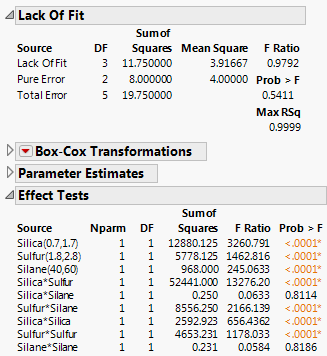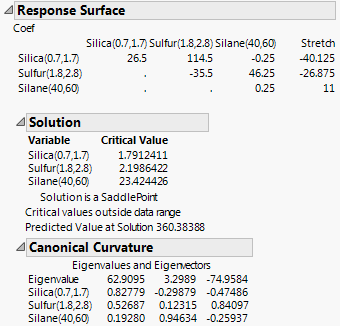Analyze the Experimental Data
1. Select Help > Sample Data Library and open Design Experiment/Bounce Data.jmp.
The file Bounce Data.jmp contains your experiment results.
2. Run the Model script.
Notice that the main effects in the Construct Model Effects list are followed by the & RS suffix. This suffix indicates that these are response surface effects, which produce a Response Surface report in the Standard Least Squares report.
3. Click Run.
Figure 11.6 Lack of Fit and Effect Tests Reports
There is no indication of lack of fit and the Effect Tests report indicates that all but two higher-order terms (Silica*Silane and Silane*Silane) have p-values below 0.0001. SeeLack of Fit and Effect Tests in Fitting Linear Models for more information about interpretation of the tables in Figure 11.6.
4. Click the disclosure icon next to Response Surface to open the report.
5. Click the disclosure icon next to Canonical Curvature.
Figure 11.7 Response Surface Report
The Coef table shown as the first part of the report gives a concise summary of the estimated model parameters. The first three columns give the coefficients of the second-order terms. The last column gives the coefficients of the linear terms. To see the prediction expression in its entirely, select Estimates > Show Prediction Expression from the Response Stretch red triangle.
The Solution report gives the coordinates of the point where the single critical value occurs. In this instance, that point is a saddle point (a point where neither a maximum nor a minimum occurs) and falls outside the range of the design space.
The Canonical Curvature report shows eigenvalues and eigenvectors of the effects. These give information about the nature and direction of the surface’s curvature. The large positive eigenvalue of 62.9095 indicates positive curvature and the eigenvector values indicate that the curvature is primarily in the Silica direction. The large negative eigenvalue of -74.9584 indicates negative curvature and the eigenvector values indicate that the curvature is primarily in the Sulfur direction.
SeeResponse Surface Model Example in Fitting Linear Models for more information about the response surface analysis tables in Figure 11.7.
Next, use the prediction profiler and the contour profiler to find optimal settings.

